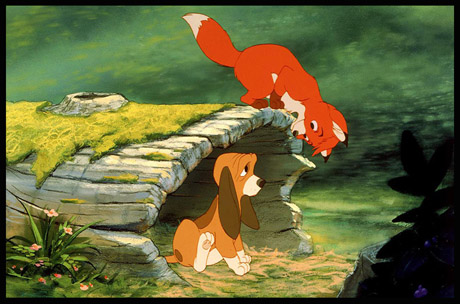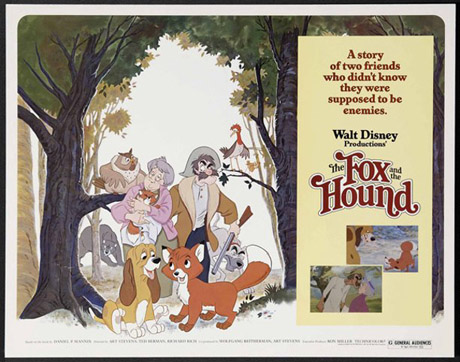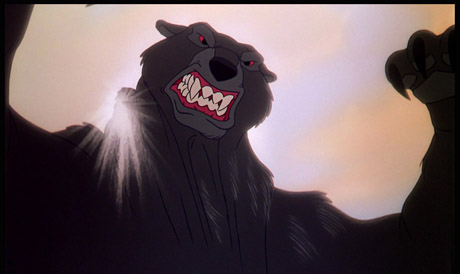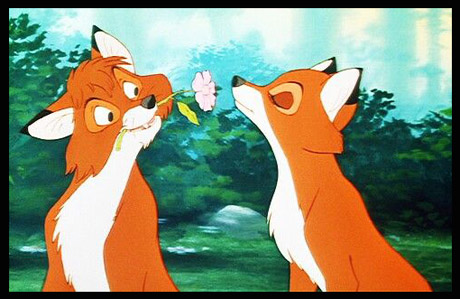
For a film that is so pure, quiet, and earnest, The Fox and the Hound arrived at Disney during one of the studio’s most tumultuous times.
In what has become a well-documented and pivotal moment in animation history, during production on The Fox and the Hound in September of 1979, Don Bluth led a walkout of a group of fourteen animators (including himself) from Disney.
The artists stated that they disagreed with the direction in which Disney was taking their animated projects, and they intended to create a studio of their own, which Bluth would, of course, do with such features as 1982’s The Secret of Nimh and An American Tail (1986).

However, on that late summer day in 1979, the production of The Fox and the Hound was crippled. Talent quickly marched out the door, forcing the Disney studio to push the feature’s release date from Christmas of 1980 to summer 1981.
The team that remained on The Fox and the Hound included such legendary Disney veterans as Frank Thomas, Ollie Johnston, Art Stevens, and Wolfgang Reitherman. They rallied during these troubled times, bringing audiences a film that was respectful to Disney’s traditions and sought to break new ground.
This month marks the fortieth anniversary of The Fox and the Hound, a film with roots at the Disney studio that goes back to 1967, the year after Walt Disney passed away. That was the year that the Disney studio reportedly bought the rights to the novel of the same name by author Daniel P. Mannix.
Ten years later, the film was put into production at Disney and went through several iterations. One of these featured a scene with two swooping cranes, who were to be voiced by noted Spanish-American singer Charo and Disney voice regular Phil Harris. The sequence, which was to include a musical number, was eventually dropped.

Disney’s The Fox and the Hound (co-directed by Stevens with newcomers Richard Rich and Ted Berman making their directorial debuts) centered on an orphaned fox pup named Tod, who becomes friends with a hound dog puppy named Copper.
As they grow up, the two realize that they aren’t meant to be friends. Tod and Copper struggle to hold on to their friendship, as they internally battle with what the world expects from them and what their heart is telling them.
Although Phil Harris and Charo never made it into the cast, The Fox and the Hound continued a Disney tradition of pairing well-known voices with the characters. Mickey Rooney would voice adult Tod, while Kurt Russell (a Disney mainstay with his years in the live-action “Dexter Riley” college comedies) played adult Copper. Singer Pearl Bailey was Big Mama, the caring owl who finds Tod when he is orphaned. Veteran character actors Jack Albertson played the hunter Amos Slade and Dick Backalyan was Dinky the bird.
As pups, the two title characters were voiced by child actors Keith Mitchell (who would later change his last name to Coogan) and Corey Feldman as Copper. The two would go on to careers as teen stars later in the 80s.
Studio voice regulars are also part of the cast with Paul (Tigger), Winchell as boomer the woodpecker, Jeannette Nolan as Widow Tweed, Pat Buttram as the dog Chief, John McIntyre as a badger, and the recognizable John Fiedler as a porcupine.

While there were familiar elements about The Fox and the Hound, the film also provided some innovative moments. Like The Rescuers, the film provided an arena for the newer generation of Disney animators to stretch their artistic wings (among them, Tim Burton and Brad Bird).
Another was Glen Keane, who would become one of the studio’s standout artists, and a legend in the industry, particularly during the animation renaissance of the 90s. In The Fox and the Hound, Glen animated the climactic battle with a mammoth bear.
As Frank Thomas and Ollie Johnston remembered in their book, The Disney Villain, Glen had asked if he could take the sequence on. Using the dinosaur battle in 1940’s Fantasia as inspiration, Glen created storyboard sketches. As Frank and Ollie wrote:
“He added swirling mist from a waterfall, savage scenes of brute force for the bear, strength and darting moves for the fox and the hound. It was a thrilling climax to the picture and set up the emotional impact of the rebirth of the friendship between the two animals. Glen’s concept when far beyond the ordinary story sketches that he had been given and established him as a top directing animator for the new era.”
In addition to such artistic moments, The Fox and the Hound also broke new ground with its story, telling a story in which friendship and caring overcome pre-conceived prejudices that others may impose on us.

Forty years after its release on July 10, 1981, The Fox and the Hound is fondly remembered, not just by those who first saw it and grew up with it that summer in theaters, but subsequent generations, as well.
Like The Great Mouse Detective, which came along five years later and also celebrated an anniversary this month, The Fox and the Hound provided a solid foundation for Disney’s decade of blockbusters that would follow in the 1990s.
In his review of The Fox and the Hound when it was released, noted film critic Roger Ebert summed up the film’s significance when he wrote: “It’s not just cute animals and frightening adventures and a happy ending, it’s also a rather thoughtful meditation on how society determines our behavior.”
- An Eye for A Classic: The 60th Anniversary of “Mr. Magoo’s Christmas Carol” - December 22, 2022
- A Very Merry Mickey: The 70th Anniversary of “Pluto’s Christmas Tree” - December 19, 2022
- A Fine French Feline Film: The 60th Anniversary of “Gay Pur-ee” - December 12, 2022


 July 28th, 2021
July 28th, 2021  Michael Lyons
Michael Lyons  Posted in
Posted in  Tags:
Tags: 






